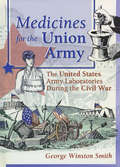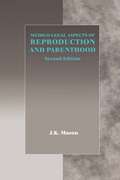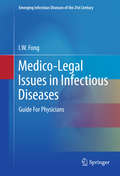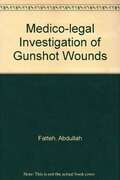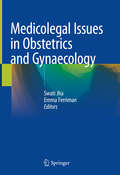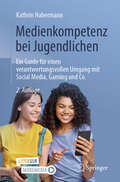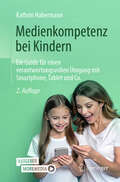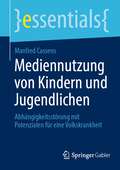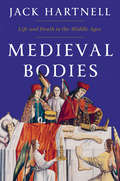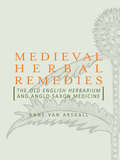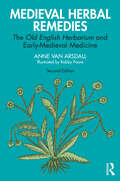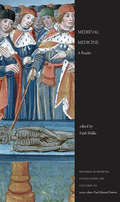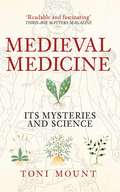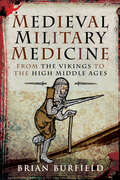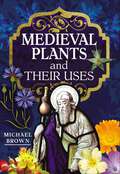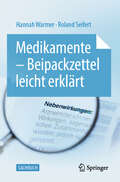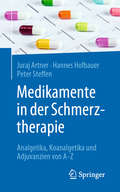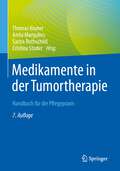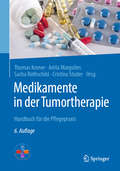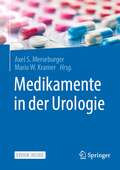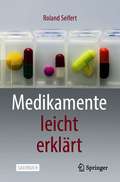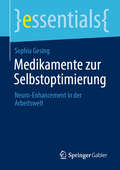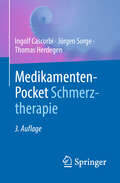- Table View
- List View
Medicines as a Service: A New Commercial Model for Big Pharma in the Postblockbuster World
by Tewodaj Mengistu Soeren Mattke Lisa KlautzerThe pharmaceutical industry can reconfigure its considerable resources to develop innovative and meaningful business models that are based on services that improve access and adherence to prescription drugs for common chronic conditions. Such innovation beyond drug development is consistent with the core capabilities of large pharmaceutical companies and has the potential to achieve profit levels similar to those of its traditional models.
Medicines for the Union Army: The United States Army Laboratories During the Civil War
by Dennis B Worthen Greg HigbyIt wasn't only combat that killed during the Civil War!Among white Federalist troops alone, there were 1,213,685 cases of malaria, 139,638 cases of typhoid fever, 67,762 cases of measles, 61,202 cases of pneumonia, 73,382 cases of syphilis, and 109,202 cases of gonorrhea between May 1, 1861 and June 30, 1866. (Statistics for Negro troops covered less than three years of the Civil War period.)Preventative medicine at the time had little more to offer than quinine and a few disinfectants. There was no real understanding of the germ theory of disease. But Medicines for the Union Army: The United States Army Laboratories During the Civil War shows that in the evolution of the army's Medical Department from incompetence to general efficiency during this time, and in the vastly improved organization and supply system designed by William A. Hammond, Jonathan Letterman, the medical purveyors, and others working under the Surgeon General, there was evidence of a great achievement.In Medicines for the Union Army you will come to understand the medical purveying system of the time and its problems, and you will witness the birth, growth, and remarkable achievements of the Federal government's pharmaceutical laboratories at Astoria, New York, and Philadelphia, Pennsylvania.Medicines for the Union Army will inform and enlighten you about the these laboratories, including: the funding and transportation obstacles faced at the Astoria lab the processes by which raw materials became drugs ready for distribution drug testing and inspection methods the bottling of “medicinal whiskey” and wine at the labs the people whose work laid the foundation for modern drug production and distribution methods the contents of the medical supply cases (panniers) and wagons in use at the time . . . and much more!Medicines for the Union Army: The United States Army Laboratories During the Civil War brings to light the groundbreaking achievements of unsung American heroes working to preserve life while the country was in bloody turmoil. No Civil War historian should be without this volume!
Medico-Legal Aspects of Reproduction and Parenthood (Medico-Legal Series)
by J.K. MasonThose involved in family and sexual relationships today face a bewildering variety of medico-legal dilemmas. These are encountered from as early as the preconception state of the embryo and continue throughout the period of child raising until the status of the mature minor is achieved. This book dissects a wide range of legal, medical and ethical issues surrounding reproduction and the parental relationship with the resultant child. Questions posed in the various sections include: what constitutes sexual intercourse, what are the implications of contraception and sterilization, is the abortion issues dead?. Is there a right to reproduce and, if so, how is this applied to the modern methods of assisted reproduction?. Is surrogate motherhood acceptable or workable?. The concept of fetal rights is explored and specific attention is given to the management of defective neonates in the light of recent judicial decisions. Other chapters look at the parent/child relationship in respect of medical treatment and the book concludes with a review of the interfamilial protection of young children under both the civil and the criminal law. Many of the views expressed are novel in that they represent those of a medical doctor exploring the legal field. It is neither a conventional book on family law nor one on medical law; rather, it draws on both to examine a specific area which affects both in a particularly significant way. Both statute and case law have been extensively updated since the publication of the first edition.
Medico-Legal Issues in Infectious Diseases
by I. W. FongThe aim of this book is not to encourage defensive medical practice, but to help provide better, optimum care to patients and to be forth right and honest to our dear customers about our inevitable mistakes. This book will focus on clinical issues facing physicians in different settings (which can lead to malpractice), and the best approach to use to avoid litigations, and practice good medicine.
Medicolegal Investigation of Gunshot Wounds
by Adbullah FattehWas written by an expert who at the time was a D.M.E. a visiting professor of Pathology and a consultant to the Criminal Justice Institute at Fort Lauderdale, Florida. Clearly written and easily understood, the book deals with all aspects of medicolegal investigation of gunshot wounds and deaths.The duties and responsibilities of the medical investigators and the police are explicitly outlined and guidelines are established for co-operative efforts between the two. The investigation of homicides, suicides, and accidents involving firearms, including investigation of the scene of the injury or death.
Medicolegal Issues for Diagnostic Imaging Professionals
by Colin M. Howles Zeev Shoham Robert J. Parelli David. K WeissmanThe constant advances in diagnostic imaging have had an impact on the practice, attitudes, and moral values of all who participate in health care. Now in its fourth edition, the original Medicolegal Issues for Radiographers has been updated and retitled, broadening the scope of content to include issues essential to all diagnostic imaging pr
Medicolegal Issues in Obstetrics and Gynaecology
by Swati Jha Emma FerrimanThis book highlights minimum standards relating to the management of different conditions in the practice of Obstetrics and Gynaecology. The editors explore clinical governance issues, common causes of as well as ways to avoid litigation. The UK is experiencing a dramatic increase in medico-legal claims. The 4 main reasons for litigation are: accountability, the need for an explanation, concern with standards of care and compensation. However the decision to take legal action is determined not only by the original injury, but failure to provide information, an explanation and an apology. Insensitive handling of an injury and poor communication after the original incident increases the risk of litigation and erodes the patient-doctor relationship. Doctors almost never deliberately cause harm to patients, however increasingly claims are being defended successfully. This book is invaluable to clinicians and lawyers alike and raises awareness of how to avoid facing clinical negligence claims in our day to day practice.
Medienkompetenz bei Jugendlichen: Ein Guide für einen verantwortungsvollen Umgang mit Social Media, Gaming und Co.
by Kathrin HabermannSurfen, Zocken, Posten, Streamen Haben Sie sich schon einmal gefragt, was Snapchat eigentlich wirklich ist und wie Social Media Apps Geld mit Daten verdienen? Oder wie gefährlich Online-Games wirklich sind beziehungsweise, ob sie sogar Vorteile für die Entwicklung bieten? Worauf sollte man beim Thema Datenschutz konkret achten? Wie sieht eine gelungene Anleitung zum Umgang mit digitalen Medien aus? Wie kann man ChatGPT erfolgreich in den Schulalltag integrieren? Erfahren Sie in diesem Ratgeber für Eltern, Pädagog*innen und Therapeut*innen, was Jugendliche selbst über ihren Medienkonsum denken und welche Medienkompetenzen heute notwendig sind, um gesellschaftlich nicht den Anschluss zu verlieren. Aus dem Inhalt: Auswirkungen digitaler Medien auf Gehirnentwicklung, Konzentration und Suchtverhalten von Jugendlichen, Einsatz digitaler Medien in Schulen, Chancen und Risiken von Social Media und Gaming, Onlinehandel und Datenschutz, Richtlinien zur gesunden Screentime und Anlaufstellen für Eltern. Plus Material- und Spiellisten, Mediennutzungsvertrag und mehr zum Download und als Kopiervorlage. Diese 2. Auflage ist komplett überarbeitet und aktualisiert mit der neuesten Literatur und Studienlage.
Medienkompetenz bei Kindern: Ein Guide für einen verantwortungsvollen Umgang mit Smartphone, Tablet und Co.
by Kathrin HabermannDieser Ratgeber unterstützt Eltern, Pädagog*innen und Therapeut*innen dabei, die Faszination von Smartphones für Kinder zu verstehen, die Bedeutung von Langeweile zu erkennen und ihren Kindern einen verantwortungsvollen Umgang mit digitalen Medien zu vermitteln. Lernen Sie, wie Sie mit der ständigen Präsenz von Smartphones, Tablets und Co. gelassen und kreativ umgehen können und welche wissenschaftlichen Erkenntnisse zu diesem Thema relevant für die Entwicklung Ihres Kindes sind. Bieten Sie Kindern attraktive Alternativen und zahlreiche einfache Spiele für den täglichen Gebrauch. Entdecken Sie spannende und entwicklungsfördernde Aktivitäten, die wenig Material und kaum Vorbereitungszeit erfordern. Erhalten Sie Praxistipps für herausfordernde Situationen wie Restaurantbesuche, lange Autofahrten oder Bahnreisen. Nach diesem Ratgeber sind Sie bestens vorbereitet. Plus: Wissenschaftliche Hintergründe und aktuelle Studien übersichtlich und verständlich aufbereitet, Fragebögen und Checklisten zur Ermittlung des Medienkonsums, Material- und Spiellisten, Mediennutzungsvertrag und mehr zum Download und als Kopiervorlage.
Mediennutzung von Kindern und Jugendlichen: Abhängigkeitsstörung mit Potenzialen für eine Volkskrankheit (essentials)
by Manfred CassensSpätestens seit Ende der 1990er Jahre zeichnete sich über eine für normal befundene Nutzung des Internets eine Gruppe von stoffungebundenen Verhaltens- als Abhängigkeitsstörungen ab, die mit dem Internet in Verbindung gebracht werden. Dies sind: Computerspielen, die pathogene Nutzung sozialer Netzwerke, das Online Shopping und der Cybersex. Gegenwärtig (2023) ist jedoch lediglich das Computerspielen in das aktuelle Klassifikationsinstrument der Krankheiten, die ICD-11, aufgenommen worden. Aktuelle diagnostische Tools basieren dabei vor allem auf psychologischen Testmanualen und klinischen Abklärungsgesprächen. Dieses essential reflektiert die aktuelle Gesamtsituation auf Basis epidemiologischer Erkenntnisse und diskutiert darüber hinaus indizierte diagnostisch erweiterte Optionen.
Medieval Bodies: Life And Death In The Middle Ages (Wellcome Collection)
by Jack HartnellWith wit, wisdom, and a sharp scalpel, Jack Hartnell dissects the medieval body and offers a remedy to our preconceptions. Just like us, medieval men and women worried about growing old, got blisters and indigestion, fell in love, and had children. And yet their lives were full of miraculous and richly metaphorical experiences radically different from our own, unfolding in a world where deadly wounds might be healed overnight by divine intervention, or where the heart of a king, plucked from his corpse, could be held aloft as a powerful symbol of political rule. In this richly illustrated and unusual history, Jack Hartnell uncovers the fascinating ways in which people thought about, explored, and experienced their physical selves in the Middle Ages, from Constantinople to Cairo and Canterbury. Unfolding like a medieval pageant, and filled with saints, soldiers, caliphs, queens, monks and monstrous beasts, this book throws light on the medieval body from head to toe—revealing the surprisingly sophisticated medical knowledge of the time. Bringing together medicine, art, music, politics, philosophy, religion, and social history, Hartnell's work is an excellent guide to what life was really like for the men and women who lived and died in the Middle Ages. Perfumed and decorated with gold, fetishized or tortured, powerful even beyond death, these medieval bodies are not passive and buried away; they can still teach us what it means to be human. Some images in this ebook are not displayed due to permissions issues.
Medieval Herbal Remedies: The Old English Herbarium and Anglo-Saxon Medicine
by Anne Van ArsdallThis book presents for the first time an up-to-date and easy-to-read translation of a medical reference work that was used in Western Europe from the fifth century well into the Renaissance. Listing 185 medicinal plants, the uses for each, and remedies that were compounded using them, the translation will fascinate medievalist, medical historians and the layman alike.
Medieval Herbal Remedies: The Old English Herbarium and Early-Medieval Medicine
by Anne Van ArsdallFeatured here is a modern translation of a medieval herbal, with a study showing how this technical treatise on herbs was turned into a literary curiosity in the nineteenth century. The contours of this second edition replicate the first; however, it has been revised and updated throughout to reflect new scholarship and new findings. New information is presented on Oswald Cockayne, the nineteenth-century philologist who first translated the Old English medical texts for the modern world. Here the medieval text is read as an example of technical writing (i.e., intended to convey instructions/information), not as literature. The audience it was originally aimed at would know how to diagnose and treat medical conditions and knew or was learning how to follow its instructions. For that reason, while working on the translation, specialists in relevant fields were asked to shed light on its terse wording, for example, herbalists and physicians. Unlike many current studies, this work discusses the Herbarium and other medical texts in Old English as part of a tradition developed throughout early-medieval Europe associated with monasteries and their libraries. The book is intended for scholars in cross-cultural fields; that is, with roots in one field and branches in several, such as nineteenth-century or medieval studies, for historians of herbalism, medicine, pharmacy, botany, and of the Western Middle Ages, broadly and inclusively defined, and for readers interested in the history of herbalism and medicine.
Medieval Medicine: A Reader (Readings in Medieval Civilizations and Cultures)
by Faith WallisMedical knowledge and practice changed profoundly during the medieval period. In this collection of over 100 primary sources, many translated for the first time, Faith Wallis reveals the dynamic world of medicine in the Middle Ages that has been largely unavailable to students and scholars. The reader includes 21 illustrations and a glossary of medical terms.
Medieval Medicine: Its Mysteries And Science
by Toni MountThis book tells the unfinished story of medicine even as some of its medieval practices are currently being revived in man's continuing quest to conquer disease. Leeches are making a comeback in microsurgery and honey is being 'rediscovered' as an effective antibiotic and promoter of healing mechanisms. As the mysteries of medieval medicine continue to be re-examined, who can tell what other strange methods of treatment or unlikely sounding ingredients may prove to be the next wonders of medicine?
Medieval Military Medicine: From the Vikings to the High Middle Ages
by Brian BurfieldA study of how doctors and surgeons treated the brutal injuries and illnesses suffered by medieval combatants. Soldiers of the Middle Ages faced razor-sharp swords and axes that could slice through flesh with gruesome ease, while spears and arrows were made to puncture both armor and the wearer, and even more sinister means of causing harm produced burns and crush injuries. These casualties of war during the 500-year period between the ninth and thirteenth centuries in Northern and Western Europe are the focus of Brian Burfield&’s study, but they represent just a portion of the story—disease, disability, disfigurement, and damaged minds all played their roles in this awful reality. Surgical methods are described in the book, as are the fixes for fractured skulls, broken bones, and damaged teeth. Disfiguring scars and disabling injuries are examined alongside the contemporary attitudes toward them. Also investigated are illnesses like dysentery and St. Anthony&’s Fire, plus infected wounds which were often deadlier than the weapons of the age. A final chapter on the psychological trauma caused by war is included and contains a significant focus on the world of the Vikings. Burfield&’s account features many individual cases, extracting their stories of wounds, sickness, and death from chronicles, miracle collections, surgeries, government records, and other documents. The prose, poetry, and literature of the period are also of great value in bringing these cases to life, as is the evidence provided by modern archaeological and historical scholarship.
Medieval Plants and their Uses
by Michael BrownPlants were an essential part of medieval life. Most people lived in houses made of wood and thatch, which often accidentally burned down when they cooked their food or huddled over wood fires to keep warm. People wore linen clothing dyed with plants. They drank ale, cider and wine as they danced to music played on wooden instruments. Beauty, love and seduction could all be made easier with a few herbal preparations. If you became ill, plants provided many of the cures. The unwary may have mistaken a poisonous plant for one that was good to eat, with fatal consequence. Others may have used the poisonous plant to remove an unwanted rival. Some plants had magical properties. The mysterious mandrake could kill anybody who tried to dig it up without taking the appropriate precautions. Demons could be summoned or dismissed by the aid of plants. The church used powerful incense to clean the air and induce a sense of religious euphoria. This book is designed to give a broad introduction to the plants that were used during the medieval period. With many colorful photos, a list of plants that were available and some original medieval recipes to try, you can set out on an adventure to explore the wonderful world of medieval plants.
Medikamente - Beipackzettel leicht erklärt
by Roland Seifert Hannah WarmerViele Menschen nehmen regelmäßig Medikamente ein, haben aber Probleme damit, Gesundheitsinformationen über Medikamente zu finden, zu verstehen und umzusetzen. Beipackzettel sind oft unverständlich, zu ausführlich und beängstigend. Der Arzt hat zu wenig Zeit, und die Informationen, die man in der Apotheke bekommen hat, hat man zuhause angekommen schon wieder vergessen. Wenn Sie regelmäßig Medikamente einnehmen, aber nicht so genau wissen, wofür Sie welches Medikament einnehmen und was Sie über Ihre Medikamente wissen sollten, dann ist dieses Buch für Sie genau richtig. In diesem Buch werden die am meisten verschriebenen Arzneistoffe einfach, verständlich und kurz erklärt.
Medikamente in der Schmerztherapie: Analgetika, Koanalgetika und Adjuvanzien von A-Z
by Juraj Artner Hannes Hofbauer Peter R. SteffenDas Werk beschreibt 100 in der Schmerztherapie eingesetzte Pharmaka nach ihrem Wirkprofil. Die Autoren, langjährig erfahrene Schmerztherapeuten, fokussieren dabei auf die für die Praxis relevanten Fakten und beleuchten auch Off-Label-Anwendungen der Medikamente. Darüber hinaus liefert das Werk Tipps für den richtigen Einsatz, Entscheidungshilfen für die richtige Medikamentenwahl sowie Informationen bei besonderen Fragestellungen. Das Werk wendet sich an alle Ärzte, die Patienten mit akuten oder chronischen Schmerzen optimal und differenziert behandeln möchten und Orientierung bei der Auswahl der richtigen Substanz benötigen.
Medikamente in der Tumortherapie: Handbuch für die Pflegepraxis
by Simone Widmer Laetitia Mauti Elisabeth Adams Martina Bertschinger Johanna Bouzid Manuela Dobler Céline StäubleÜber 250 Medikamentenprofile von A bis ZDieses Buch richtet sich an Pflegende von Tumorpatientinnen und -patienten und bietet alle wichtigen Informationen zu den in der Onkologie eingesetzten Medikamenten. Bleiben Sie auf dem neuesten Stand im Umgang mit tumorwirksamen Arzneimitteln und kompetent in der Beratung Ihrer Patientinnen und Patienten. Durch die alphabetische Anordnung finden Sie schnell das gesuchte Medikament und Antworten auf die häufigsten Fragen. Besonders wertvoll und hilfreich sind die prägnanten Patienteninformationen am Ende jedes Profils. So können Sie differenziert beraten und Betroffene vertrauensvoll begleiten.
Medikamente in der Tumortherapie: Handbuch für die Pflegepraxis
by Ursula Schmid Simone Widmer Laetitia MautiÜber 210 Medikamentenprofile von A bis ZDieses Buch richtet sich an Pflegende von Tumorpatienten und bietet alle wichtigen Informationen zu den in der Onkologie eingesetzten Medikamenten.Bleiben Sie up to date im Umgang mit tumorwirksamen Arzneimitteln und kompetent in der Beratung Ihrer Patienten. Durch die alphabetische Anordnung finden Sie schnell das gesuchte Medikament und Antworten auf die häufigsten Fragen. Besonders wertvoll und hilfreich sind die prägnanten Patienteninformationen am Ende jedes Profils. So können Sie differenziert beraten und Betroffene vertrauensvoll begleiten.
Medikamente in der Urologie
by Axel S. Merseburger Mario Wolfgang KramerUrologisches Medikamentenwissen kompaktDas Buch mit seinen über 150 Medikamentenprofilen ist das ideale Nachschlagewerk für alle Urologen. Schnell und zuverlässig erhält der Arzt alle wichtigen Informationen zu den praxisrelevanten Arzneimitteln, u.a. Wirkung, Nebenwirkungen, Indikationen, Wechselwirkungen und Dosierung. Zusätzlich werden Besonderheiten, zu berücksichtigende Einflussfaktoren (z.B. das Alter) und Hinweise zu Patienteninformationen gegeben.Knapp und handlich bündelt es das pharmakologische Wissen u.a. zur Infektiologie, Inkontinenz, Uroonkologie und möglichen Notfällen urologischer Patienten. Abgestimmt auf das, was jeder Urologe wissen muss.
Medikamente leicht erklärt
by Roland SeifertFast jeder Bundesbürger nimmt Arzneimittel ein, häufig mehrere. Aber oft haben weder Arzt noch Apotheker ausreichend Zeit, dem Patienten zu erklären, warum er ein Arzneimittel benötigt, wie es wirkt und welche unerwünschten Wirkungen es hat. Schaut der Patient dann in den Beipackzettel, wird er meist nicht aufgeklärt, sondern verunsichert. Das führt dann zu Complianceproblemen in der Arzneitherapie. Häufig gehen Patienten auch zu mehreren Ärzten, ohne dass diese davon wissen (Ärzte-Hopping). Verschreiben diese Ärzte mehrere Arzneimittel, kann es zu gefährlichen Wechselwirkungen kommen. Der Gesetzgeber hat diese Problematik erkannt und deshalb kürzlich das Gesetz für mehr Sicherheit in der Arzneimittelversorgung (GSAV) in Kraft gesetzt. Aber für den Patienten ist es schwierig sich objektiv zu informieren. Zwar findet er im Internet unendlich viele „Informationen“, aber Zusammenhänge und Gewichtungen lassen daraus meist nicht herauslesen. Am Ende ist die Verwirrung größer als vorher. Dieses Sachbuch klärt auf und liefert die Fakten, die man als Patient wissen muss.
Medikamente zur Selbstoptimierung: Neuro-Enhancement in der Arbeitswelt (essentials)
by Sophia GesingDieses essential stellt umfassend die aktuellen Erkenntnisse zu Neuro-Enhancement dar. Dieser Begriff beschreibt ein Phänomen der heutigen Arbeitswelt, bei dem Medikamente gezielt zur Selbstoptimierung eingenommen werden. Es werden Bedeutung und Verbreitung von Neuro-Enhancement erörtert, Erklärungsansätze zu den Motiven hinter der Einnahme gegeben sowie die konsumierten Substanzarten näher erläutert. Zudem werden die Wirksamkeit und die Risiken fundiert dargelegt. Eine moralische Bewertungsdiskussion sowie Handlungsempfehlungen und Alternativen zur Einnahme verschreibungspflichtiger Medikamente zur Leistungs- und Wohlbefindenssteigerung runden dieses essential ab.
Medikamenten-Pocket Schmerztherapie
by Ingolf Cascorbi Jürgen Sorge Thomas HerdegenMedikamente sind ein zentraler Baustein in der Therapie akuter und chronischer Schmerzen. Dieses Taschenbuch hilft allen in der Allgemeinmedizin und schmerztherapeutisch tätigen Ärztinnen und Ärzten dabei, den Überblick über die Vielzahl von Analgetika für die Behandlung zu bewahren. Hier finden Sie: Pharmakokinetik, Dosierungen und Äquivalenzdosen, Wirkungen, Nebenwirkungen, Wechselwirkungen sowie gesetzliche Grundlagen für die Verordnung von Opioidanalgetika und Cannabionoiden. In der 3. Auflage komplett überarbeitet und um das Kapitel Cannabinoide erweitert.

